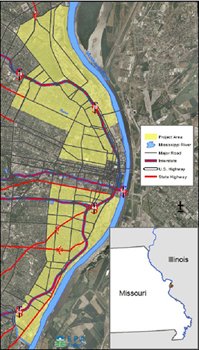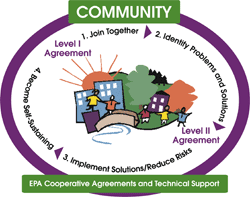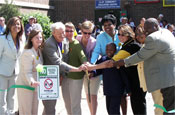Community Action for a Renewed Environment (CARE)
Grace Hill Clean Air Project
Fall 2007

About CARE
Community Action for a Renewed Environment (CARE) is an EPA technical assistance and grant program that offers an innovative way for a community to organize and take action to reduce toxic pollution in the local environment.
Level I, Level II Grants
Awarded at two monetary levels, over two years, CARE grants help communities tackle their problems using a four-step process (see diagram below). Level I grants (up to $100,000) enable communities to progress through the first two steps, which are: 1) build a broad-based partnership and 2) identify a range of environmental problems and solutions. Level II grants (up to $300,000) fund the next two steps, which are: 3) take action to reduce risks and 4) become self-sustaining.

St. Louis, Missouri
The Grace Hill Clean Air Project (GHCAP) involves the St. Louis neighborhoods located along the west side of the Mississippi River to the north of the city and adjacent to downtown St. Louis to the south. This area is primarily low-income, ethnically and racially diverse, bisected by highways, and interspersed with industry. Approximately 20 percent of the areas population earns less than $10,000 per year, and many individuals lack a high school diploma and are considered single heads-of-households.
GHCAP is an outgrowth of the Community Air Project (CAP), which was founded in 2000 to identify and address environmental issues in the area. CAP identified air quality as the communitys primary environmental health concern, conducted air monitoring, identified air pollutants as the highest priority, and developed a portfolio of projects to reduce these pollutants. With CARE Level II funding, GHCAP is able to implement projects identified by CAP, continue building additional partnerships, and increase community involvement.

Step 1: Joining Together
With its clear objectives and dedicated staff first established under CAP, GHCAP received a CARE Level II grant and has retained CAPs original partners, as well as attracted numerous businesses, organizations, and agencies as new partners. GHCAP maintains strong community involvement through meetings, activities, and events, and the project conducts quarterly stakeholder meetings and interim meetings to report on the status of efforts involving partners and community members.
Step 2: Identifying Problems, Solutions
CAP used the results of a Listening Tour organized by EPA, which identified air quality as the community's primary environmental concern. CAP then conducted air monitoring, developed health benchmarks, and analyzed the data, ultimately identifying and prioritizing six air pollutants of highest concern: acetaldehyde, formaldehyde, benzene, arsenic, chromium, and diesel particulate matter.
Step 3: Implementing Solutions, Reducing Risks
GHCAP works on five main projects:
- Pollution Prevention with Businesses: GHCAP conducts workshops to educate metal finishers, electroplaters, and auto body shops on pollution prevention in the workplace. GHCAP also has worked to reduce coal dust blowing from a coal yard into the adjacent Laidlaw school bus yard, which was impacting bus drivers and children. Working with the Missouri Department of Natural Resources, the coal yard changed its work practices to reduce pollution.
- Idling Prevention: With GHCAPs assistance, the St. Louis Public School Board passed a resolution establishing a No Idling Zones campaign in all 88 district schools. The campaign consists of bright green striping along curbs and colorful signage where buses and parents drop off and pick up children, and educates students, parents, and bus drivers about the benefits of not idling. As of June 2007, 600 bus drivers had signed cards pledging not to idle their vehicles.
- Hotline: The Clean Air Hotline is GHCAPs 24 hour/7 days a week phone line for citizens to call when they see, smell, or taste something of concern in the air. Project staff forwards the calls to the proper authorities and follows up with the caller.
- Green Cleaners: Because no green household cleaning supplies are commercially available in low-income neighborhoods, GHCAP has produced and distributed, free of charge, more than 1,000 bottles of its own household green cleaner.
- General Education: GHCAP offers an adult education course each calendar quarter that teaches students how to reduce pollution and its associated health risks in their homes.

Partners join together for a ribbon-cutting ceremony at Clay Elementary School, opening the first No Idling Zone at a public school in St. Louis.
Step 4: Becoming Self-Sustaining
GHCAP continues to reach out to the community through ongoing discussions with partners focused on creating a no idling state law and strengthening green initiative policies within the city of St. Louis. In addition, several partners are on board to implement key pieces of GHCAP. For example, the St. Louis Department of Public Works Maintenance Department will assist with maintaining the No Idling Zones campaign and will continue bus driver education at the Laidlaw Bus Company.
Partners
- Grace Hill Settlement House
- City of St. Louis Air Pollution Control
- Laidlaw Bus Co.
- Mallinckrodt Co.
- Metropolitan Sewer District, Bissell Plant
- Missouri Department of Natural Resources
- St. Louis Association of Community Organizations
- St. Louis City Mayor Francis Slay
- St. Louis Public Schools and School Board
- St. Louis Regional Asthma Consortium
- U.S. EPA Region 7
- Many others
For Further Information
Please visit the CARE Web site for more information.
Gwen Yoshimura
(yoshimura.gwen@epa.gov), U.S. EPA Region 7 Project Lead
U.S. EPA Region
7
(913) 551-7073
Douglas Eller
(douglase@gracehill.org), CARE Project Lead
Clean Air Project, Grace Hill
Settlement House
(314) 584-6703
PDF Versions
- Grace Hill Clean Air Project , Fall 2007 (PDF) (2 pp, 340K, About PDF)
